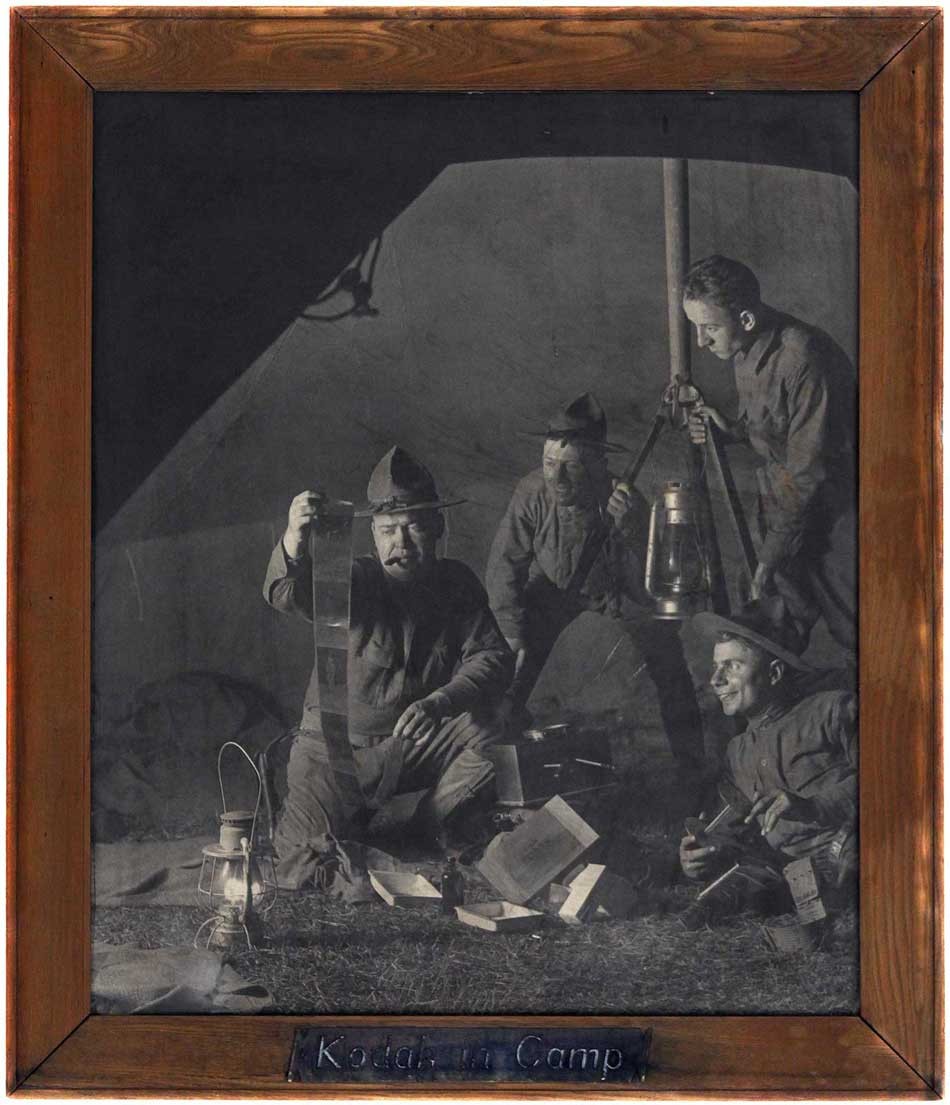From the Trenches a Century On
Posted November 2018 in Advertising, History of Photography, Photography, Significant Photographs, Unknown Photographers
For your consideration, we offer a happier vision of patriotic leanings supporting the home-front on this milestone day in history marking the end of World War 1.
 "Kodak in Camp": vintage framed bromide print ca. 1917 by unknown American photographer: Image Dimensions: 71.4 x 60.0 | cm 83.2 x 71.8 cm stained oak frame. This rare mammoth-sized Kodak advertising photograph featuring American “Doughboys” working together developing film in their tent at night was used by the Eastman company in their “Take a KODAK With You” advertising campaign. In late 1917, it appeared in publications including The Saturday Evening Post and The Independent (with which is incorporated Harpers Weekly) From: PhotoSeed Archive
"Kodak in Camp": vintage framed bromide print ca. 1917 by unknown American photographer: Image Dimensions: 71.4 x 60.0 | cm 83.2 x 71.8 cm stained oak frame. This rare mammoth-sized Kodak advertising photograph featuring American “Doughboys” working together developing film in their tent at night was used by the Eastman company in their “Take a KODAK With You” advertising campaign. In late 1917, it appeared in publications including The Saturday Evening Post and The Independent (with which is incorporated Harpers Weekly) From: PhotoSeed Archive
On the Eleventh Hour of the Eleventh Day of the Eleventh Month- November 11, 1918, the signing of the Armistice ending the Great War took place 60 kilometers north of Paris inside a railway carriage parked in the Forest of Compiègne. It has now been 100 years since that fateful day, on that fateful month and on that fateful hour. Sadly, mankind seems doomed to repeat his failures.
But a pivoting to Photography in relation to these weighty issues will always be of interest to the historian.
In 1914, the role of the medium expanded greatly at the outset of World War 1. In addition to photography’s new found power through smaller cameras to document unspeakable human suffering and death by the millions brought about by trench warfare, aerial reconnaissance photography gave countries the ability to monitor troop movements and to devise strategy in nearly real time. And then there was the home-front. The Eastman Kodak Company was certainly not going to let a war get in the way in order to call attention to their brand and sell more product.
Retooling like other large concerns in order to become an essential military contractor, they saw American Doughboys entering the war late in the conflict as brand ambassadors. As proof, the Kodak Vest Pocket camera, which debuted in 1912, found its’ way onto the front lines and trenches of many battlefields-legally or otherwise, and advertising posters hawking the camera as well as this oversized framed bromide print of soldiers for darkroom supplies and film called Kodak in Camp prominently appeared displayed in camera shops throughout the country.
And Kodak went further. As part of their national print advertising campaign dubbed “Take a KODAK with you”, this photo of nighttime developing in camp appeared full page in the pages of the Saturday Evening Post magazine for their August 4, 1917 issue as well as other publications around that time.
But most importantly, we honor the memory today of all the fallen. In a tribute to just one, a Scottish photographer by the name of Nichol Elliot, whose 1917 death in wartime Belgium is memorialized by a volume of his pictorial photographs accompanied by poems written by his wife Alice Elliot, we give her final stanza from An Idyll of Peace:
How swift from summer idylls came the wrench
Of life flung thence, by war and manhood’s will,
To battle roar and glare, or deathly chill
Of watch and warfare in the nightmare trench!
For peace divine man paid diviner price ⎯
In world-wide idyll of high sacrifice.
-Paired with Nichol Elliot photograph: In the Island, Toronto
For additional background on photography and the Great War, check out this New York Times Lens blog post from 2014.
This entry was posted on Sunday, November 11th, 2018 at 6:00am and is filed under Advertising, History of Photography, Photography, Significant Photographs, Unknown Photographers. You can follow any responses to this entry through the RSS 2.0 feed.